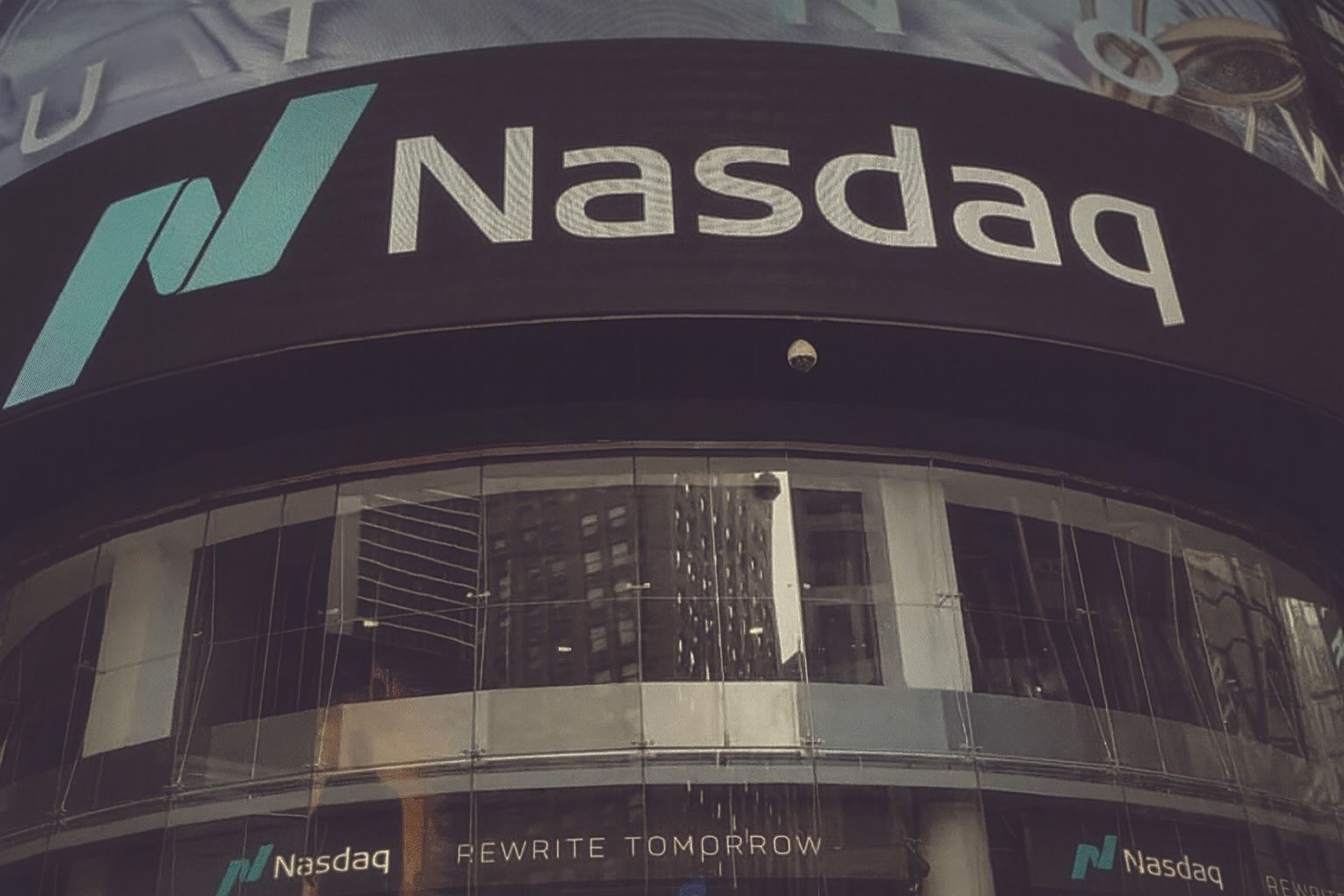Key Facts – October 18, 2025
- Nasdaq Climbs Despite Jitters: The Nasdaq Composite closed at 22,679.98 on Friday, up 117 points (+0.5%) [1]. This capped a volatile week where the tech-heavy index notched a weekly gain and remains near all-time highs, up roughly mid-teens in percentage year-to-date [2].
- Tech Stock Whiplash:Nvidia (NVDA) hit record highs (~$195) in early October then dipped to ~$180 mid-week as investors took profits [3]. It remains ~58% higher year-on-year amid an AI-fueled boom [4]. AMD (AMD), meanwhile, surged 34% in one day after announcing a multi-year AI chip deal with OpenAI on Oct. 6 [5] [6], its biggest jump in 9 years. Broadcom (AVGO) also jumped ~10% after unveiling a $10 billion AI partnership with OpenAI [7]. Major chip equipment maker KLA Corp (KLAC) spiked 13% this week as analysts hiked targets on AI and memory demand [8].
- Biotech & Health Leaders: Healthcare stocks provided pockets of strength. On Oct. 1, news of U.S. drug pricing reforms sent Pfizer up 6.8% and Eli Lilly up 5.0% [9]. The Nasdaq Biotech Index ticked higher into mid-October (around 5,100, from ~4,900 late September) [10], though biotech trades remained choppy with no single breakout story dominating. Defensive health names helped stabilize the market during tech sell-offs.
- Market Drivers – Earnings and Geopolitics: Strong bank earnings lifted financials, while regional bank fears flashed then eased. The KBW Regional Bank Index sank 5% Thursday then rebounded ~1.7% Friday [11] after banks like Zions and Western Alliance addressed loan loss and fraud issues. “Some calm has come in over…overblown worries in the regional bank area,” noted strategist Ryan Detrick, adding the financial sector is likely still on “firm footing” [12]. Trade war angst whipsawed sentiment: last week U.S. tariff threats on Chinese goods sparked the Nasdaq’s worst selloff in months, but President Trump’s reversal on a proposed 100% China tariff and plans to meet Xi Jinping calmed markets [13]. “We’ve seen this movie before… now [Trump’s] clearly putting water on that fire,” Detrick said of the abrupt shift [14].
- Volatility Spikes, Outlook Clouded: The market’s fear gauge (VIX) hit an intraday high of 28.99 this week – its highest in ~6 months – before settling near 20 [15]. Traders are bracing for bigger swings, even as indexes hover near records. “Risk appears to be expanding,” strategist Jordan Rizzuto observed, signaling higher volatility ahead despite the market’s recent highs [16]. Observers note stock valuations are elevated and breadth is narrowing (only ~57% of S&P 500 members remain in uptrends, down from 77% in July) [17], heightening sensitivity to any “incremental risk catalysts” [18]. Upcoming tests include big tech earnings (Tesla reports Wednesday, Netflix on Tuesday) [19] and a delayed U.S. inflation report, which could all sway the Nasdaq’s next move.
Nasdaq Ends Week Higher Amid Roller-Coaster Trading
After a roller-coaster week, the Nasdaq Composite Index managed to finish in positive territory, showcasing resilience in the face of multiple risk flare-ups. The index closed Friday at 22,679.98 points, up 117.44 points (+0.52%) on the day [20]. All three major U.S. indices posted weekly gains, even as intraday swings tested investors’ nerves. The tech-heavy Nasdaq remains within striking distance of its record high (~23,000) set earlier this month, and is up roughly 15–17% for the year to date [21] – a strong performance reflecting 2025’s bullish momentum.
Volatility made a comeback in recent days. The CBOE Volatility Index (VIX), Wall Street’s “fear index,” briefly spiked to around 29, a level not seen since April, before easing back to ~20 by week’s end [22]. That intraday surge in volatility underscores investors’ fragile sentiment: after a long stretch of calm, markets are suddenly confronting a confluence of risks. “The market is becoming more volatile, but it’s also coming off of a very non-volatile period,” explained Michael Reynolds of Glenmede, noting that with stock valuations at full levels, any new shock can jolt markets [23] [24]. Indeed, traders rushed into protective options this week – bets that would pay out if the VIX jumps into the 40s – reflecting rising anxiety about near-term turbulence [25].
Despite the bumps, Nasdaq’s overall uptrend remains intact. Friday’s rebound helped the index secure a weekly advance. Safe-haven flows that sent gold to record highs (above $4,200/oz) earlier in the week began to reverse [26], and U.S. Treasury yields ticked back up toward 4% on the 10-year note [27] as some fear over trade and credit issues abated. In short, investors ended the week in a cautiously optimistic mood – relief that worst-case scenarios (a full-blown regional banking crisis or escalating trade war) were avoided, tempered by recognition that markets are not out of the woods yet.
Tech Titans in Turmoil: Big Winners and Losers
It was a whipsaw week for tech titans on the Nasdaq. Early in the week, semiconductor stocks – the year’s high-flyers – experienced sharp reversals. Leading AI-chip maker Nvidia (NVDA), which had soared to all-time highs near $195 a share in early October, suddenly pulled back mid-week on profit-taking and jitters over high valuations. By October 14, Nvidia tumbled over 4% in a single session (to around $180) as traders cashed in gains [28]. The stock then bounced off those lows, closing around $182 on Oct. 17 [29]. Nvidia remains a market darling – still up roughly 35% year-to-date and an eye-popping 58% higher than a year ago [30] – but its volatile swings highlight the push-pull between AI euphoria and investor caution. On one hand, Nvidia’s fundamentals are spectacular (revenue up 56% last quarter, with data-center sales hitting a record $41 billion) [31]. On the other, at ~50× earnings, the stock is priced for perfection, making it sensitive to any hint of demand slowdown or competition [32].
Advanced Micro Devices (AMD) stole the spotlight earlier in October with a stunning rally. On Oct. 6, AMD announced a landmark deal to supply hundreds of thousands of AI chips to OpenAI, including giving OpenAI an option to take a 10% stake in AMD. Investors reacted with an emphatic buy signal – AMD’s stock surged over 34% in one day, its largest one-day gain since 2016 [33] [34]. The deal, expected to bring tens of billions in revenue to AMD, was hailed as “transformative” for the industry [35], confirming AMD as a credible challenger in an AI chip market long dominated by Nvidia. Analysts called it a major “vote of confidence” in AMD’s technology [36]. While Nvidia’s dominance isn’t in jeopardy (it still sells every AI chip it can make), AMD’s stock has been on a tear, and the OpenAI partnership underscores the voracious appetite for AI hardware across the industry [37] [38].
Other chipmakers and tech leaders saw big moves as well. Broadcom (AVGO) shares rallied strongly on news of a $10 billion AI accelerator partnership with OpenAI. The stock jumped ~10% on Oct. 13 when the deal was unveiled [39], part of a surge that has Broadcom up about 70% in 2025 [40]. Broadcom’s market cap pushed past $1.5 trillion this month amid the AI frenzy [41]. Likewise, semiconductor equipment firms benefited from the optimism – KLA Corp (KLAC), which makes chip production tools, spiked 13% this week after bullish analysts at Bank of America and Stifel dramatically raised their price targets, citing robust demand for AI chips and memory gear [42]. These outsized gains illustrate how AI news has become a key driver for Nasdaq stocks: any hint of a major AI investment or customer win is met with a rush of buying.
Mega-cap tech stalwarts saw more measured moves. Apple (AAPL) hovered just below record highs around $247–$250 per share [43]. The iPhone maker staged a small rally mid-week after a surprise launch of new M5 chip-based MacBooks and iPads, though the stock gave back some gains on mild profit-taking [44]. Apple’s stock is roughly flat on the year (+1–2% YTD) despite being only a few dollars shy of its all-time high [45] [46] – a sign that much of its resurgence was retracing late-2024 losses. Analysts are split on Apple’s next leg: bulls like Wedbush see a coming “golden era” and have hiked price targets (one to $310) amid an iPhone 17 upgrade “supercycle,” while bears argue the stock’s rich valuation already reflects a lot of good news [47]. Notably, Apple has been a stabilizing force during recent market turmoil – its huge $3.8 trillion market cap and steady cash flows make it a safe haven within tech. Case in point: during an Oct. 14 selloff on trade war fears, Apple dipped early but quickly rebounded to finish flat, showing “surprising resilience amid the crossfire” compared to more volatile peers [48] [49].
Electric vehicle giant Tesla (TSLA) also made headlines off the trading floor. In an “October shockwave,” Tesla unveiled a slew of developments: early builds of a long-promised ~$30K affordable EV, a major Autopilot software update (even as U.S. regulators probe its safety) [50], and CEO Elon Musk’s refocusing of Tesla’s AI efforts (inking a $16.5 billion deal with Samsung for next-gen chips) [51]. While Tesla’s stock was relatively steady this week, hovering around the mid-$200s, these moves set the stage for potential volatility ahead of its earnings report (due next week). Musk’s aggressive bets – including his own recent $1 billion personal stock purchase (reported in a TS2.tech analysis) – have bulls excited for Tesla’s long-term prospects, even as ISS advises shareholders to push back on Musk’s proposed mega pay package tied to a near-$1 trillion valuation goal [52].
In the biotech and healthcare arena, there wasn’t a single dominant Nasdaq mover, but the sector quietly contributed to the market’s strength. Early in the month, defensive health-care stocks popped on policy news: Pfizer (PFE) and Eli Lilly (LLY) saw their shares jump ~5–7% in a day after U.S. officials announced plans to rein in Medicaid drug prices [53]. The Nasdaq Biotech Index has climbed from late-September lows, reaching roughly 5,100 in mid-October (up from ~4,900) [54]. Still, biotech news was a mixed bag. Some smaller names saw outsized gains on clinical updates – for instance, psychedelic drug developer MindMed doubled in a week on trial breakthroughs, according to TS2.tech reports – but others slumped on disappointing data. The takeaway is that biotech remains highly stock-specific: while the sector didn’t lead the Nasdaq’s charge, it served as a source of defensive rotation when tech faltered. Traders often hide in big pharma or diversified biotechs during tech downturns, which helped cushion the index during the October volatility.
Earnings Season Kicks Into Gear as Macro Risks Loom
Beyond individual stocks, the broader market narrative for the Nasdaq in mid-October has been a tug-of-war between strong corporate earnings and macro/geopolitical headwinds. This week marked the first big wave of Q3 earnings reports, and so far results are impressive. More than half of S&P 500 companies have reported, with about 86% beating profit expectations – a very high “beat rate” [55]. Analysts now project S&P 500 earnings growth around +9.3% year-on-year for the quarter, an uptick from estimates at the start of the month [56]. Robust reports from major banks (Goldman Sachs, Morgan Stanley, etc.) and tech firms have provided a fundamental backstop for stocks. Notably, regional banks – a source of angst recently – delivered reassuring news: mid-sized lenders Truist and Fifth Third posted better-than-expected results [57], helping stem the slide in bank shares.
However, it hasn’t been all smooth sailing. On Thursday, credit fears around a few regional banks caused a temporary scare. Zions Bancorp revealed a surprise $50 million loan loss tied to a fraudulent borrower, and Western Alliance disclosed a related fraud lawsuit [58]. Those headlines sent regional bank stocks plunging ~5% in one day. The Nasdaq, which includes many fintech and smaller bank stocks, felt the ripple as investors feared a spreading problem. By Friday, cooler heads prevailed: no systemic issues emerged, and bank stocks bounced back [59]. “It took a night to sleep on it, but some calm has come in over the probably overblown worries in the regional bank area,” said Carson Group’s Ryan Detrick, noting that only a couple of banks had bad news and “it’s not systemic.” [60] His words proved prescient as dip-buyers stepped in, and the regional bank index regained nearly 2% [61]. The episode highlighted both the market’s jitters and its underlying resilience – investors are swift to sell on rumor, but also quick to buy when worst fears don’t materialize.
The other major overhang was the U.S.–China trade skirmish. Last week, President Donald Trump shocked markets by floating a possible 100% tariff on all Chinese imports by November 1 as retaliation for China’s tech export curbs. That saber-rattling triggered the Nasdaq’s worst one-day drop since spring. But in a dramatic about-face, Trump dialed it back late this week: on Friday he called such extreme tariffs “not sustainable” and confirmed an upcoming meeting with China’s President Xi Jinping to negotiate [62]. The mere hint of détente sparked a relief rally. “We’ve seen this movie before,” quipped Detrick. “A week ago, President Trump was talking 100% tariffs and the market had its worst selloff in months – and now today he’s clearly putting some water on that fire.” [63] Indeed, trade-sensitive stocks (manufacturers, chipmakers with China exposure) rebounded as traders wagered the direst outcomes will be avoided. Still, uncertainty lingers – the planned Trump-Xi meeting in two weeks will be a critical event for the market, and any surprise hiccups in trade talks could quickly reignite volatility. As one Wells Fargo strategist noted, U.S.–China developments remain “key for markets in the coming week.” [64]
On the macroeconomic front, investors have been juggling mixed signals. Interest rates are top of mind, as ever. After a surge to multi-year highs earlier in 2025, bond yields have been seesawing. This week, as panic over banks and trade receded, the 10-year Treasury yield crept back above 4.0% [65]. Federal Reserve Chair Jerome Powell made headlines in mid-October by hinting that if the labor market continues to soften, the Fed could consider rate cuts in coming months – a dovish signal that gave stocks a mid-week boost [66]. In fact, on the day Powell spoke, the Dow Jones swung from a 300-point loss to a solid gain, and the Nasdaq erased its morning drop [67]. Traders took this as reassurance that the Fed won’t over-tighten into weakness. However, with inflation still above target, the timing of any Fed pivot remains uncertain. Next week’s inflation report (the delayed September CPI reading, due Friday) will be crucial. A hotter-than-expected CPI could spook the bond market and pressure high-growth tech stocks, while a cooler inflation print might bolster the case for a Fed pause or even cuts. In short, macro data has market-moving potential, and the Nasdaq’s trajectory could shift on a dime with each new economic reading.
Meanwhile, safe-haven assets reflected the market’s gyrations. Gold prices, which had been on a tear, briefly hit a record high above $4,300/oz amid the height of trade war and bank fears [68]. By Friday, as the dollar strengthened and panic subsided, gold pulled back ~2%, breaking its upward streak [69]. Oil prices were little changed on the week, but the geopolitical backdrop – from Middle East tensions to global supply questions – kept investors alert. Any significant flare-up on the world stage (be it in commodities, currency markets, or geopolitics) could trickle down to tech stocks via risk sentiment.
Expert Views: Caution Flags and Bullish Horizons
Market experts are divided on what lies ahead for the Nasdaq. On one side, there’s recognition that the fundamental backdrop is strong – earnings are beating expectations, the economy is proving resilient, and the Nasdaq just entered a new bull market cycle in 2025. Historical analysis from TS2.tech notes that this is the Nasdaq’s seventh bull market since 1990, and past six cycles delivered an average gain of +281% over about 5 years [70]. If history rhymes, the tech-heavy index could have substantial upside into 2026 and beyond. Bulls argue that revolutionary trends like AI, cloud, and electric vehicles could power another multi-year expansion. Every previous Nasdaq bull run has eventually pushed to new highs, and the index is only ~1% below its record now [71]. From that perspective, the recent volatility may just be a healthy shake-out before the next leg higher. “The latest bull [market]…signals a new cycle for growth-focused tech stocks,” the TS2.tech report explains, noting the long-run tendency for tech indices to “trend higher in extended uptrends.” [72]
On the other side, warning flags are flying. Valuations for many Nasdaq favorites are stretched – the index trades at roughly 30× forward earnings, its priciest level in years. “Once you have valuations hit sort of full levels… you have to be on the lookout for incremental risk catalysts,” cautions Glenmede’s Michael Reynolds [73]. Those catalysts are now emerging, from higher interest rates to geopolitical unknowns. One sign of concern: market breadth has narrowed, meaning fewer stocks are driving the gains. Only about 57% of S&P 500 stocks are still in uptrends, down from 77% in the summer [74]. A rally led by a shrinking pool of mega-caps can be vulnerable if those leaders falter. Some strategists are also wary of the volatility uptick. “Risk appears to be expanding,” says TS2.tech’s Jordan Rizzuto, who sees the VIX’s rise as an omen of choppier waters ahead even as indexes hover near peaks [75]. And with the Nasdaq’s “Magnificent Seven” (Apple, Microsoft, Amazon, Nvidia, Google, Tesla, Meta) carrying such heavy weight, any stumble in a big name could drag on the whole index.
Several near-term events could determine whether the Nasdaq’s next move is a surge to new records or a deeper pullback. Earnings season will hit a climax next week with reports from tech giants Tesla (Wednesday) and Netflix (Tuesday), among others [76]. Investors will scrutinize guidance from these leaders for any cracks in the growth story. Also on tap is that key CPI inflation report (pushed to Oct. 24 due to the earlier government shutdown delays) – a hotter CPI could reignite rate hike fears, while a benign figure might fuel a relief rally. Additionally, the end-of-month Federal Reserve meeting and the Trump–Xi summit in early November loom large. “The U.S.-China trade issue will be key for markets in the coming week,” notes Wells Fargo’s Doug Beath [77], emphasizing that any surprise in trade negotiations could roil stocks.
For now, many analysts advise a balanced approach. Take profits on euphoria, but don’t abandon tech’s long-term growth. “It’s natural to see a bit of a pullback” after such a strong run, said Matthew Keator of the Keator Group [78], suggesting some profit-taking is healthy. But longer-term, the secular trends driving the Nasdaq – AI, digital transformation, biotech breakthroughs – remain intact. The index’s ability to weather this week’s turmoil and still finish higher is seen as a testament to that enduring strength.
Bottom Line: The Nasdaq’s October ride has been anything but boring. Yet despite volatility, the index is showing resilience – absorbing bad news and bouncing back when fears prove overblown. As the tech rally enters a more mature phase, investors should brace for bigger daily swings and potential air-pockets, especially around major news. The coming days will bring pivotal data and earnings that could either turbocharge the Nasdaq to fresh highs or validate the caution of skeptics. In the longer view, the Nasdaq’s new bull market is alive and well, but it faces its stiffest test of 2025 in this final stretch of the year. Will the bulls charge ahead into 2026, or will mounting risks force a detour? The answer may depend on the next few headlines – and Wall Street is watching closely.
Sources: Nasdaq/Investopedia, Reuters, TS2.tech Market Analysis [79] [80] [81], company filings, and expert commentary. All data as of October 18, 2025.
References
1. www.reuters.com, 2. ts2.tech, 3. ts2.tech, 4. ts2.tech, 5. www.reuters.com, 6. www.reuters.com, 7. ts2.tech, 8. ts2.tech, 9. ts2.tech, 10. ts2.tech, 11. www.reuters.com, 12. www.reuters.com, 13. www.reuters.com, 14. www.reuters.com, 15. ts2.tech, 16. ts2.tech, 17. www.reuters.com, 18. www.reuters.com, 19. www.reuters.com, 20. www.reuters.com, 21. ts2.tech, 22. ts2.tech, 23. www.reuters.com, 24. www.reuters.com, 25. ts2.tech, 26. www.reuters.com, 27. www.reuters.com, 28. ts2.tech, 29. ts2.tech, 30. ts2.tech, 31. ts2.tech, 32. ts2.tech, 33. www.reuters.com, 34. www.reuters.com, 35. www.reuters.com, 36. www.reuters.com, 37. www.reuters.com, 38. www.reuters.com, 39. ts2.tech, 40. ts2.tech, 41. ts2.tech, 42. ts2.tech, 43. ts2.tech, 44. ts2.tech, 45. ts2.tech, 46. ts2.tech, 47. ts2.tech, 48. ts2.tech, 49. ts2.tech, 50. ts2.tech, 51. ts2.tech, 52. ts2.tech, 53. ts2.tech, 54. ts2.tech, 55. www.reuters.com, 56. www.reuters.com, 57. ts2.tech, 58. www.reuters.com, 59. www.reuters.com, 60. www.reuters.com, 61. www.reuters.com, 62. www.reuters.com, 63. www.reuters.com, 64. www.reuters.com, 65. www.reuters.com, 66. ts2.tech, 67. ts2.tech, 68. www.reuters.com, 69. www.reuters.com, 70. ts2.tech, 71. www.reuters.com, 72. ts2.tech, 73. www.reuters.com, 74. www.reuters.com, 75. ts2.tech, 76. www.reuters.com, 77. www.reuters.com, 78. ts2.tech, 79. www.reuters.com, 80. ts2.tech, 81. ts2.tech







